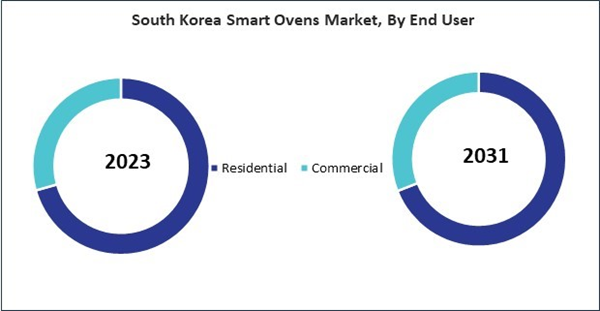The residential smart ovens market is experiencing rapid growth driven by advancements in technology and changing consumer lifestyles. These innovative kitchen appliances offer homeowners convenient and efficient cooking solutions by combining traditional oven functionalities with smart features. Equipped with internet connectivity, touchscreen interfaces, and compatibility with smart home ecosystems, smart ovens enable users to control cooking remotely, access recipes, and receive cooking alerts via mobile devices. Therefore, in India, 579.87 hundred units of smart over would be utilized for residential use by the year 2031.
The China market dominated the Asia Pacific Smart Ovens Market by Country in 2023 and would continue to be a dominant market till 2031; thereby, achieving a market value of $80 million by 2031. The Japan market is capturing a CAGR of 14.6% during (2024 - 2031). Additionally, The India market would register a CAGR of 16.1% during (2024 - 2031).
Many smart ovens offer built-in recipe libraries and guided cooking features that provide step-by-step instructions for preparing various dishes. Users can select a recipe from the oven's interface, and the oven will automatically set the cooking time and temperature, guiding the user through each step of the cooking process. Some smart ovens offer health and wellness features like calorie tracking, nutritional information, and diet-specific recipe suggestions. These features cater to consumers' interest in health-conscious cooking and eating habits. Smart oven manufacturers are paying more attention to the design and aesthetics of their products, offering sleek and modern designs that complement contemporary kitchen aesthetics. Stainless steel finishes, touchscreen displays, and minimalist interfaces are becoming increasingly common.
Kitchen space is often limited in urban areas, and consumers seek compact and space-saving appliances. Smart ovens, particularly countertop models, are ideal for urban kitchens where space is premium. Urban consumers tend to be more tech-savvy and are early adopters of smart home technology. Smart ovens, with their advanced features and connectivity options, appeal to urban consumers looking for modern and innovative home solutions.
China is experiencing rapid urbanization, with millions of people moving from rural areas to cities yearly. The growing number of urban households in China has created a large market for smart home appliances. Urban consumers in China have higher disposable income levels than rural consumers. Urban lifestyles in China are fast paced, with many consumers juggling work, family, and social commitments. With growing concerns about environmental pollution and energy consumption, Chinese consumers are increasingly seeking energy-efficient and eco-friendly home appliances.
As per the State Council of China, urbanization has accelerated rapidly throughout China in recent years, with the National Bureau of Statistics estimating that the rate increased to 64.72 percent last year. As of the end of 2022, 914 million people were living in cities, an increase of 12.05 million from 2021. Therefore, due to the above-mentioned factors, the smart ovens market will grow significantly in this region.
Based on Type, the market is segmented into Counter-top, and Built-in. Based on Distribution Channel, the market is segmented into Offline, and Online. Based on End User, the market is segmented into Residential, and Commercial. Based on countries, the market is segmented into China, Japan, India, South Korea, Australia, Malaysia, and Rest of Asia Pacific.
List of Key Companies Profiled
- LG Electronics, Inc. (LG Corporation)
- Whirlpool Corporation
- Sharp Corporation
- Hitachi, Ltd.
- Robert Bosch GmbH
- Panasonic Corporation
- Samsung Electronics Co., Ltd.
- Techtronic Industries Co., Ltd.
- Tovala
- June Life, Inc.
Market Report Segmentation
By Type (Volume, Hundred Units, USD Billion, 2020-2031)- Counter-top
- Built-in
- Offline
- Online
- Residential
- Commercial
- China
- Japan
- India
- South Korea
- Australia
- Malaysia
- Rest of Asia Pacific
Table of Contents
Companies Mentioned
- LG Electronics, Inc. (LG Corporation)
- Whirlpool Corporation
- Sharp Corporation
- Hitachi, Ltd.
- Robert Bosch GmbH
- Panasonic Corporation
- Samsung Electronics Co., Ltd.
- Techtronic Industries Co., Ltd.
- Tovala
- June Life, Inc.
Methodology

LOADING...









